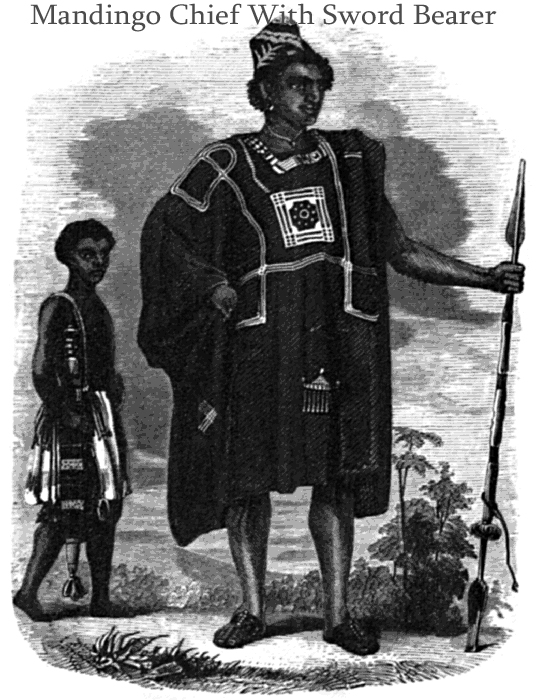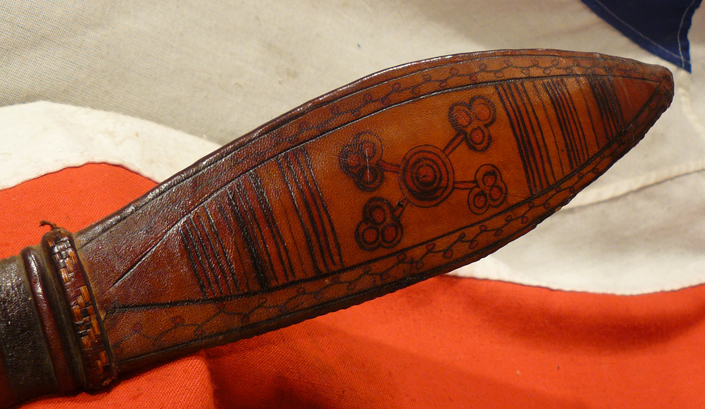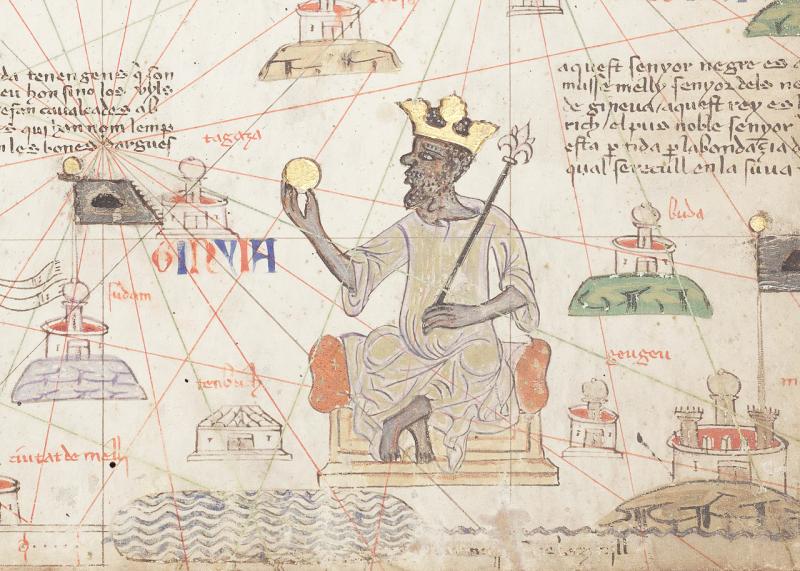19th Century, Antique, Mandingo Mandinka Chief's Slave and Gold Trader's Sword With Tattooed-Leather Covered Wooden Scabbard
A most scarce and original African slave and gold trader chieftain's sword
The Manding (Mandingo) are West African people. Their traditional slaver's sword comprises a sabre like blade, a guardless leather grip and wide expanded scabbard with exquisite tattooed leather work.
This example is a fine example of very nice quality and most finely tattooed.
It has a 16 inches long curved blade, leather grip and leather scabbard with leaf shaped widening tip, entirely tooled tattooed and decorated. Of special interest is the finely bound and decorated leather work. These weapons are well known for their rare leather-work and the tattooing applied to the leather of the scabbards. The iron work skills are of black-smith quality.
Slave raiding, capture and trading in the Mandinka regions existed in significant numbers long before the European colonial era, as is evidenced in the memoirs of the 14th century Moroccan traveller and Islamic historian Ibn Battuta. Slaves were part of the socially stratified Mandinka people, and several Mandinka language words, such as Jong or Jongo refer to slaves. There were fourteen Mandinke kingdoms along the Gambia River in the Senegambia region during the early 19th century, for example, where slaves were a part of the social strata in all these kingdoms.
Scholars have offered several theories on the source of the transatlantic slave trade of Mandinka people. According to Boubacar Barry, a professor of History and African Studies, chronic violence between ethnic groups such as Mandinka people and their neighbours, combined with weapons sold by slave traders and lucrative income from slave ships to the slave sellers, fed the practice of captives, raiding, manhunts, and slaves. The victimised ethnic group felt justified in retaliating. Slavery was already an accepted practice before the 15th century. As the demand grew, states Barry, Futa Jallon led by an Islamic military theocracy became one of the centres of this slavery-perpetuating violence, while Farim of Kaabu (the commander of Mandinka people in Kaabu) energetically hunted slaves on a large scale. Martin Klein (a professor of African Studies) states that Kaabu was one of the early suppliers of African slaves to European merchants
Many blades were taken by the Mandingo and fitted from European weapons, such as sabres and short cutlasses. .
In general, these remain primarily considered Mandingo weapons, and from regions in Mali. These were of course invariably mounted with European sabre blades. Mandingo Tribe (also known as the Mandinka, Mande, or the Malinke Tribes) were the traders of the African West Coast, trading primarily in gold and slaves.
In 1324, Mansa Musa who ruled Mali, went on Hajj pilgrimage to Mecca with a caravan carrying gold. Shihab al-Umari, the Arabic historian, described his visit and stated that Musa built mosques in his kingdom, established Islamic prayers and took back Maliki school of Sunni jurists with him. According to Richard Turner – a professor of African American Religious History, Musa was highly influential in attracting North African and Middle Eastern Muslims to West Africa
Picture in the gallery of a Mandingo Slave Trader Chieftain, standing next to his boy sword bearer, carrying his very same form of 'tattooed' sword. One, from an original collection of weapons we recently acquired.
Overall the leather on this sword in in exceptional condition and beautifully decorated.
Early medeavil painting in the gallery of Mansa Musa's visit to Mecca in 1324 CE with large amounts of gold, that not unsurprisingly attracted many Middle Eastern Muslims and Europeans to Mali.
Code: 17969
455.00 GBP







